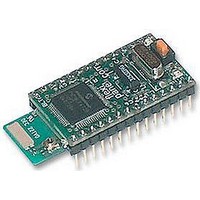TOOTHPIC RF Solutions, TOOTHPIC Datasheet - Page 8

TOOTHPIC
Manufacturer Part Number
TOOTHPIC
Description
MODULE, BLUETOOTH, DATA ACQUISITION
Manufacturer
RF Solutions
Datasheet
1.TOOTHPIC.pdf
(126 pages)
Specifications of TOOTHPIC
Svhc
No SVHC (15-Dec-2010)
Hardware Design
Mechanical drawings, technical specifications and
electrical schematics are provided at the beginning
of this document.
Power Regulation
ToothPIC power consumption is dominated by the
BlueMatik radio, whose peak current consumption
is 250mA during transmission.
consumption will be considerably lower and will
depend on Bluetooth usage. When the ToothPIC
module is turned off, the 18F6720 typically draws
20mA (plus I/O pin current drain) when clocked
with the 20MHz oscillator and 50µA with the 32kHz
oscillator.
ToothPIC may be powered with a 5V regulated
input to the Vdd pin. Maximum regulated supply
voltage is 5.5V. Minimum rated voltage is 4.5V. In
practice, ToothPIC will operate effectively down to
3V although Class I Bluetooth performance is not
guaranteed.
Alternatively, an unregulated input between 5V or
10V may be applied to the Vin pin where it will be
regulated by a 400mA regulator. In this second
case, the Vdd pin functions as a 5V regulated
power source for external circuitry. In this case,
the total current draw in all I/O pins including Vdd
must not exceed 130mA. The power regulator is a
low-dropout
unregulated power source below 5V.
A 1µF tantalum capacitor is provided between Vin
and Vss and a 100nF tantalum capacitor is
provided between Vdd and Vss.
PIC18LF6720 Microprocessor
The PIC18LF6720 microprocessor is a standard
component available from Microchip Technology
Inc which has been preloaded with the ToothPIC
Services.
component,
information available at www.microchip.com.
BlueMatik Bluetooth Radio
The PIN code, unless otherwise specified, is 0000
(four zeroes).
The BlueMatik Bluetooth Radio component is also
available as a separate product line from
FlexiPanel Ltd. For detailed information about this
component,
Page 8
9-Apr-06
For detailed information about this
type
consult
consult
Toothpick 3.0.00007
and
the
the
will
specific
specific
operate
Average current
DS380-8
as
product
product
© FlexiPanel Ltd
an
information available at www.FlexiPanel.com. The
BlueMatik documentation includes source code to
allow various remote devices to connect to it, and
also gives detailed examples of how to use the AT
Command set.
The radio has regulatory approval for USA,
Canada and certain European countries as
described in the BlueMatik documentation. The
key regulatory points are:
The radio is a 2.4GHz Class I Bluetooth device
with an integral antenna. To achieve 100m range,
the corresponding Bluetooth device must also be
Class I.
The radio module has a socket for attaching an
external antenna via the on-board Hirose U.FL
series connector (type Murata MM8430). To use
this connector, first remove the surface mount
component between the connector and the integral
antenna. Depending on the type of connector and
the mounting orientation, the PCB cutout size may
need to be increased to provide access to the
connector. The product will require re-certification
if an external antenna is used.
During design, consider the RF characteristics of
the
Experiment with the location and orientation of the
antenna and avoid locating it near conducting
materials (e.g. metal, water). Ideally, mount the
module so that the antenna overhangs the edge of
the board with no components or metal within 4cm
to the left or right.
ToothPIC is usually supplied with the BlueMatik
module glued in place. Nevertheless, care should
be taken to not to apply any rotational force on the
BlueMatik module as this may damage its
connections to the main board.
ToothPIC can also be supplied with the BlueMatik
as an optional clip-on component. This might have
applications where the Bluetooth radio is only
required for factory configuration.
•
•
•
Contains Transmitter Module FCC ID: CWTUGPZ1
environment
unmodified integral antenna is used.
marked as follows:
does not require further R&TTE certification.
Patents apply and/or pending
Approval applies only if the existing,
The exterior of the product should be
The CE mark on the module indicates that it
Contains Transmitter Module IC:1788F-UGPZ1
surrounding
www.FlexiPanel.com
the
module.



















